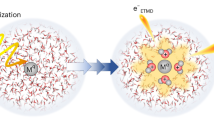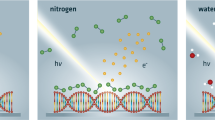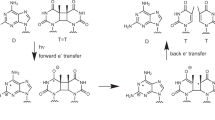Abstract
BOTH the hydrated electron, e−aq, and the hydroxyl radical, OH, which are formed as the principal intermediates in water radiolysis, react rapidly with the pyrimidine bases through preferential addition to the 5, 6 double bond to give the hydropyrimidyl radical, BH, and the hydroxypyrimidyl radical, BOH, respectively1–4. The yields for base destruction (molecules/100 eV) in oxygen-free solutions under γ-rays are, however, consistently low, G(−B) ⩽ 1 (refs. 5 and 6), when compared with primary yields of the radical species derived from water, Ge−aq = 2.85, GOH = 2.4 (ref. 7); recent work indicates that secondary reactions of BH and BOH lead to regeneration of the parent compound4. In oxygen-saturated solutions, e−aq, is scavenged by oxygen to form O−2(HO2), the regeneration reaction is quenched, and the yield for base destruction increases to G(−B)∼2 through reactions involving the peroxy radical, B(OH)⨀2. Many organic products are formed, however, from the intermediate, B(OH)⨀2, and the overall product stoichiometries have yet to be fully elucidated8.
This is a preview of subscription content, access via your institution
Access options
Subscribe to this journal
Receive 51 print issues and online access
$199.00 per year
only $3.90 per issue
Buy this article
- Purchase on Springer Link
- Instant access to full article PDF
Prices may be subject to local taxes which are calculated during checkout
Similar content being viewed by others
References
Scholes, G., Ward, J. F., and Weiss, J., J. Mol. Biol., 2, 379 (1960).
Ekert, B., and Monier, R., Nature, 188, 309 (1960).
Hart, E. J., Science, 146, 19 (1964).
Kamal, A., and Garrison, W. M., Nature, 206, 1315 (1965).
Latarjet, R., Ekert, B., and Demerseman, P., Radiat. Res., suppl., 3, 247 (1963).
Ponnamperuma, C., Lemmon, R. M., Bennett, E. L., and Calvin, M., Science, 137, 605 (1962).
Hayon, E., Trans. Farad. Soc., 61, 723 (1965).
Weiss, J., Prog. Nucleic Add Res. and Mol. Biol., 3, 103 (1964).
Baxendale, J. H., and Smithies, D., J. Chem. Phys., 23, 604 (1955).
De La Mare, H. E., Kochi, J. K., and Rust, F. F., J. Amer. Chem. Soc., 85, 1437 (1963).
Willix, R. L. S., and Garrison, W. M., J. Phys. Chem., 69, 1579 (1965).
Gordon, S., Hart, E. J., Matheson, M. S., Hart, E. J., Rabani, J., and Thomas, J. K., J. Amer. Chem. Soc., 85, 1375 (1963).
Hart, E. J., Thomas, J. K., and Gordon, S., Radiat. Res., suppl., 4, 74 (1964).
Stimson, M. M., J. Amer. Chem. Soc., 71, 1470 (1949).
Author information
Authors and Affiliations
Rights and permissions
About this article
Cite this article
HOLIAN, J., GARRISON, W. Radiation-induced Oxidation of Cytosine and Uracil in Aqueous Solution of Copper (II). Nature 212, 394–395 (1966). https://doi.org/10.1038/212394b0
Issue Date:
DOI: https://doi.org/10.1038/212394b0
Comments
By submitting a comment you agree to abide by our Terms and Community Guidelines. If you find something abusive or that does not comply with our terms or guidelines please flag it as inappropriate.



